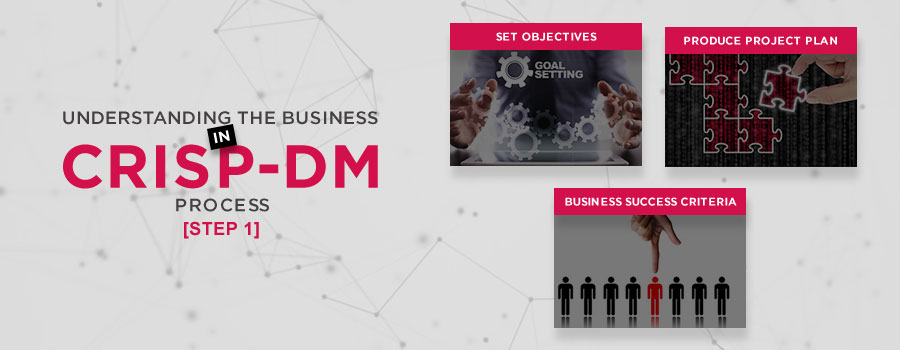The initial stage of your CRISP-DM process involves a clear understating of what you want to accomplish from your business. It is necessary to know the key factors, that may have an influence on the outcome of your project. Well, it is recommended to reach out to one of the reputed top data mining companies and seek this assistance. First of all, you need to consider the intended outputs of your project. Here is a simplified guide, that will help you to execute the data mining project.

Business Understanding (Step 1)
- Set your objectives: Setting objectives indicate that you are on a goal-oriented track. Consider the primary perspective of your business. You may address certain related questions, and proceed to the subsequent data evaluation phases. When you approach the experts, you will get a comprehensive support in data mining.
- Develop your project plan: In this stage, it is necessary to describe your crisp-dm project plan to achieve the project goals with data mining. Here, the steps that are to be executed in the next stages of the project may be highlighted.
- Criteria for success: In this stage, the criteria for achieving success in business has to be laid down. You need to incorporate certain measurable and specific parameters in the process.
Accessing your present situation
In order to get a clear insight about where you stand, you need to evaluate your present situation. Focus on your data mining business goals when you assess your present situation. You should be aware of your constraints, resources, assumptions and various other factors, that needs to be considered. Have a look at the following factors, when you evaluate your present situation.
Inventory of resources
This includes the list of resources that are necessary for the project. These include:
- Manpower (Data experts, business experts, data mining experts, technical support)
- Information (Access to live, warehoused, fixed extracts or operational data)
- Software (data mining tools and other necessary software)
- Computing resources (hardware platforms)
Necessities, assumptions, and problems
You need to create a list of all the requirements of your data mining project. This will include your schedule, quality, and the necessary comprehensibility. When you assess your data mining project plan, you should evaluate all these aspects and identify the constraints. You also need to create a list of all the assumptions in the project. However, this may also include certain assumptions, that are non-verifiable. Apart from this, you have to list the shortcomings associated with the project, for instance, the availability of resources, size of the dataset and so on.
Risks and possibilities
Here, you need to consider the risks, that may come across your path and the possibilities that can hinder your progress. Accordingly, you should think of a positive solution.
Terminology
It is necessary to create a list of data mining terminology that is relevant to the project. In general, it should have two components. One glossary will contain the business terminology, which is a part of the business understanding of the project. The other glossary will contain a terminology of data mining, with illustrated examples, that are relevant to the problem in business.
Costs and benefits
You need to develop an analysis, based on costs and benefits of the project. This will help you to compare the costs that you have to incur in the project, with the benefits that you can yield. However, you should make the comparison as specific as you can.
Determining your goals
In a business goal, you need to state the objectives of the business terminology. Again, the data mining goal expresses the objectives of the project in technical terms. You can consult the experts to know about the data mining technologies. An expert hand can provide you with the necessary assistance in data mining.
- Criteria for business success: Here, you need to explain the desired outputs of your project, that enable you to achieve the objectives.
- Criteria for success: This defines the criteria necessary for a successful outcome of the data mining project in technical terms. Here, it is necessary to explain these in the subjective terms.
Developing your project plan
While developing the project plan, you need to focus on the DM goals. The steps that are to be performed in the subsequent stages of the project are to be specified here. This includes the crisp-dm phases and the way they will be executed. It should also include the selection procedure for techniques and tools.
- Project plan: While formulating the project plan, you need to create a list of all the stages, that will be executed in the project. It should contain all the specific details, like duration, inputs, outputs, necessary resources and dependencies. Besides, you should analyze the dependencies between risks and time schedules. Accordingly, you need to come up with a strategy for your project. You also need to decide the evolution strategy, that you will require in the evaluation phase. As each of the phases end, you need to review your achievements and progress, thereby making updates in the project plan.
- Initial assessment of techniques and tools: When the first phase comes to an end, you need to carry out an initial assessment of the techniques and tools. Evaluating the techniques and tools early during the data mining process is important, as the entire project depends on the selection of the tools.
In the next post, you will come to know about phase 2, which deals with data understanding. You will get a detailed knowledge on how to collect the initial facts and figures in this section.
You can reach out to us for any sort of assistance related to data preparation crisp-dm. At PGBS, you will come across the right mix of resources and technologies for data mining. Our experts are ready to help you out. Get across to us for a seamless support in all the relevant data mining technologies.
